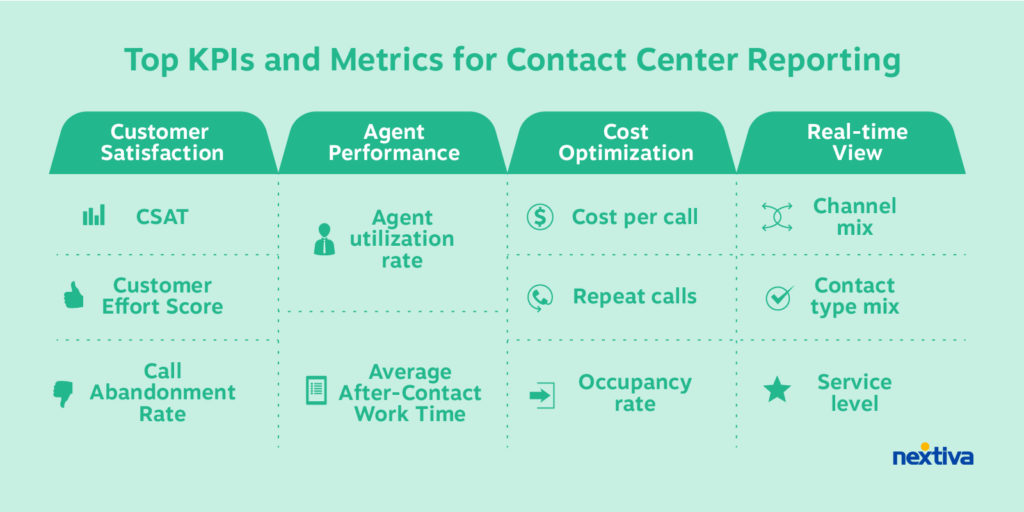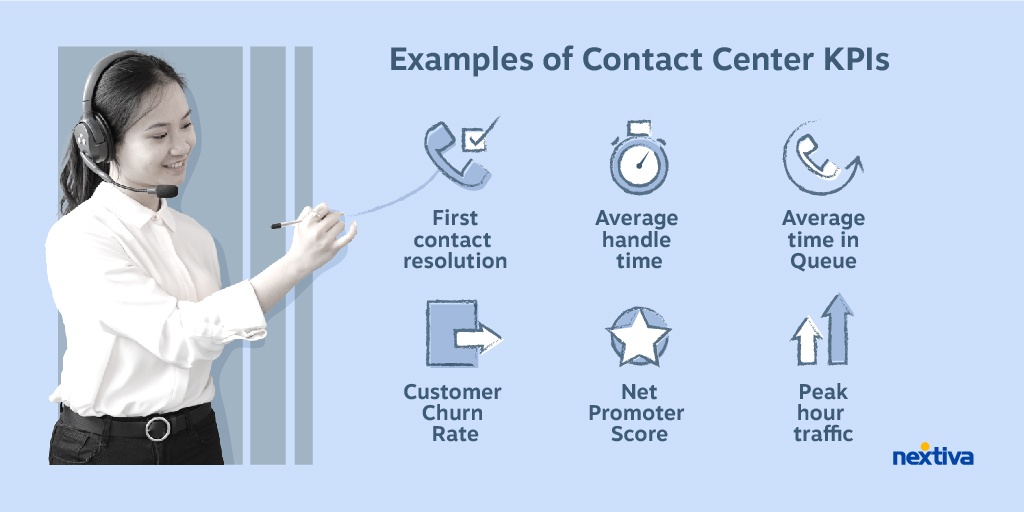Why It Matters & Best Practices

Table of Contents

Contact center reporting plays a vital role in measuring the success of your customer service operations. Unlike traditional call center reporting, contact center reporting encompasses a broader range of channels and metrics to measure the customer experience.
Contact centers have evolved beyond voice-only call centers to embrace the concept of omnichannel support. This modern approach allows customers to engage with individual agents using phone, email, SMS, web chat, and social media channels.
This guide sheds light on the methodology and significance of contact center performance metrics. By leveraging advanced reporting tools, you’ll be equipped to deliver actionable insights to your team, leading to increased agent productivity.
What Is Contact Center Reporting?
Contact center reporting is the process of organizing and presenting insights about an organization’s customer support performance. These reports include historical data, offering insights into long-term trends and real-time team performance progress.
Today’s contact center solutions provide pre-built dashboards and custom reports to track progress against specific customer satisfaction initiatives.
These dashboards serve as visual aids, helping you identify trends and grasp the complete picture of your business at a glance. Additionally, they allow you to tailor data analysis to focus on the Key Performance Indicators (KPIs) that align with your specific business goals.
In a nutshell, contact center reporting consists of:
- Real-time graphs and individual agent performance reports for team managers
- Detailed reports into contact reasons, dispositions, and customer satisfaction or NPS scores
- Staffing forecasts and team activity reports for contact center managers
- Customer experience KPIs and narratives supporting the organization’s strategic goals
So, which Key Performance Indicators (KPIs) are worth adding to your dashboard?
Your industry and business objectives determine that, but we’ll explore several of them (along with best practices) below.
Types of Contact Center Reports
When it comes to contact center operations, there are various types of reports that can provide valuable insights. Here are three of the most common ones:
- Customer Satisfaction: Measure the customer experience, and the data reflects the perception from customers, including top contact channels, resolution rates, and failed contacts.
- Agent Performance: Track agent productivity and their teams for upholding customer sentiment, maintaining resolution rates, and leveraging approved templates to shorten response times.
- Call Center Performance: Monitor the health of the call center, which is primarily voice-based. These stats include inbound call volume, average call times, and your automatic call distributor (ACD) rules to achieve optimal call routing.

Why Contact Center Reporting Matters
“Yay, another report to benchmark ourselves by,” said no one ever. I get it.
You don’t have to use classic call center metrics to measure success. You can use the raw data to reveal hidden business intelligence from the front lines.
Here’s a scenario that is sure to excite your call center agents.
Let’s say your company is dealing with a growing trend in cancellations. Members of your support team can provide the product team a short list of data-driven recommendations. Rather than provide a spreadsheet, some agents can place outbound calls to a segment of churned customers to validate the customer feedback.
Your customer support team can work alongside the product in customer interviews. But all begins with monitoring the right contact center metrics — and applying them to your situation.
Benefits & Examples of Contact Center Reporting KPIs
Here are four compelling reasons why contact center reporting benefits businesses.
1) Increase Customer Satisfaction
Raising customer satisfaction is in everyone’s best interest.
Without it, your churn rates explode, and your agents will be subject to escalations and irate customers. Your omnichannel staffing depends on what is most convenient and practical for customers.
Contact center reports provide a nuanced view of your customers. You can craft customer journeys that you monitor and adjust over time as new data becomes available. Use these contact points to truly listen and help customers gain confidence in your product — celebrate these moments too!
Metrics for customer satisfaction
- Customer Satisfaction (CSAT): This metric measures customers’ satisfaction with their overall experience. It helps gauge how well the contact center is meeting customer expectations.
- Customer Effort Score (CES): CES assesses customers’ efforts to resolve issues or complete transactions. It focuses on minimizing obstacles and repetition in the customer experience.
- Abandonment Rate: This metric tracks the percentage of incoming calls customers abandon before reaching an agent. A high abandonment rate may indicate issues with wait times or call routing.
2) Elevate Agent Performance
Empowering individual agents with the right level of autonomy and structure is critical to scaling your contact center.
Use contact center reports to monitor first-contact resolution (FCR) and the transactional NPS scores to see if they are effective in helping customers.
Unlike traditional call center analytics like average handle time, the KPI here is resolution rate rather than minimizing talk time. For instance, moving from live chat to an outbound call or a follow-up email the following day may be necessary. The issue’s “handle” time might be 25 minutes but spread over a few days.
Metrics for elevating agent performance
- Agent Activity: This report measures the productivity and engagement of contact center agents. It includes metrics like the number of calls handled, average handling time, and after-call work. It helps identify top-performing agents and areas for improvement.
- Net Promoter Score (NPS): NPS gauges customer loyalty and likelihood to recommend the contact center’s services. It is often obtained through post-interaction surveys and serves as an indicator of customer advocacy.
- Automation Template: This report focuses on the utilization and effectiveness of automated templates or scripts used by agents. It assesses the impact of automation on call handling efficiency and customer experience.
3) Optimize Call Center Operation Costs
Optimizing your spending on your call center software and live agents is a strategic goal made easier with contact center reporting.
Expanding agent capabilities from one to four contact channels, they can support multiple customers simultaneously.
Since most customer contacts involve text-based conversations, your can marry your call center performance with modern data analysis. With a vast historical data set, you can predict increased call volume accurately. With this business intelligence, you can adjust staffing levels to maintain a strong customer experience.
Metrics for optimizing costs
- Inbound Call Volume: This metric tracks the total number of incoming calls received over a specific period. It helps forecast staffing needs and assess call center operations. While being the most personal, answering inbound calls tends to be the most expensive to scale.
- First Call Resolution (FCR): FCR measures the percentage of customer issues resolved during the initial contact without requiring follow-up interactions. Higher FCR rates indicate efficient problem resolution and customer satisfaction.
- Call Duration: This report examines the average call time and average wait time experienced by customers. It provides insights into call center efficiency, wait times, and potential bottlenecks. Communicate the effect of high handle times — abandoned calls grow, and customers will race to the next support channel like social media or live chat.
4) Gain Real-Time Business Health
One of the advantages of contact center reporting is that you gain a real-time pulse of your customer experience.
Contact center managers can analyze discussions to understand agent performance and customer sentiment, but the value goes far beyond live dashboards.
Contact center reporting allows you to share live customer information with your team members. Product managers can better understand the product life cycle, and engineers can get critical insight into how product upgrades are received.
Because this information is shared as it is happening, it puts your teams ahead of the curve in responding to issues proactively before customer satisfaction is seriously affected.
Metrics for a real-time view of the business
- Omnichannel Mix: This report analyzes the distribution of customer interactions across communication channels, such as inbound and outbound calls, emails, chats, or social media. It provides insights into channel preferences and effectiveness.
- Occupancy Rates: Understand the relative capacity of your team to address customer inquiries. Without further context, this isn’t too actionable. Integrating your CRM with your contact center software lets you know the business impact of each customer interaction.
- Service Levels: Measure your ability to meet a standard of service you have set for the team. For example, 80% of customers should get a live agent response within 30 seconds of initiating contact.
The benefits of contact center metrics are hard to beat. And with these examples, you can go far above the standard “call time” stats of the past.
As you assemble your dashboard templates and custom reports, follow these best practices to make a lasting impact.
Contact Center Reporting Best Practices
🔢 Define Relevant KPIs and Analytics
The critical first step for contact center reporting is to define the KPIs and analytics that matter to your business. You must consider the full scope of your sales and product life cycles here and the nature of customer contacts you expect.
👉 Once you define the proper metrics, communicate them to your superiors and your direct reports. Not just once, but make it at least a weekly habit.

🎯 Adapt to Industry Benchmarks
Your KPIs should be more specific to their business value. Your reporting and analytics must align with real-world expectations and the customer journey map for your products.
But industry benchmarks can still be an essential part of your process when designing your contact center analytics. Your company could suffer reputation issues if your customers experience significantly longer hold times or lower FCR than your competitors.
🗳️ Capture Customer Feedback
Good contact center agents respond thoughtfully to customer questions. Great contact center agents know to ask open-ended consultative questions.
When customers divulge their pains, it increases the probability of achieving a first-contact resolution. But beyond a technical issue, you should arm agents with an effective way to capture customer pains and ideas. A cloud contact center can “listen” for these with AI, but logging these into your CRM is just as effective.
… But don’t just leave it in there. Do something with these actionable insights. Enlist your leadership team to review and respond to trending customer feedback.
👂 Listen to Agents
The hidden beauty of a contact center solution is that contact center managers can change the interface and automation easily for various teams. Gather input from your teams about their workflow and customer interactions.
When your agents become stakeholders in the design of a process, they have a natural incentive to ensure it is followed – and your key metrics will improve as a result.
Be willing to update your contact center reports to reflect a more accurate narrative. This transparency helps everyone understand how they are being measured and how they can influence their success. Plus, individual agents will appreciate the opportunity to improve the business.

📣 Share Performance Reports With Stakeholders
Graphs, charts, and raw data are only helpful if people understand and act on them.
Take the time to share vetted dashboards and KPIs with the broader business. It is the perfect way to ensure that teams, including product development, sales, and marketing, feel like stakeholders in customer satisfaction. Even a monthly summary can have a big impact.
In addition, these contact center reports help celebrate top performers for delivering superior customer satisfaction.
Build The Best Customer Experience with Contact Center Reports
“That which is measured improves. That which is measured and reported improves exponentially.”
Karl Pearson
Tracking contact center stats and agent activities is great. But measurable growth happens when there’s rigor in reporting and sharing actionable insights with the organization.
Consider novel ways to leverage the omnichannel service channel — workforce management, updating Interactive Voice Response (IVR) menus, and prioritizing at-risk accounts to get the customer care they need.
The Nextiva Contact Center is a top choice for streamlining all your support channels, automating follow-up tasks, and providing customers with a VIP experience.
Talk with one of our contact center experts today to see how we can help you scale your support and sales objectives.







